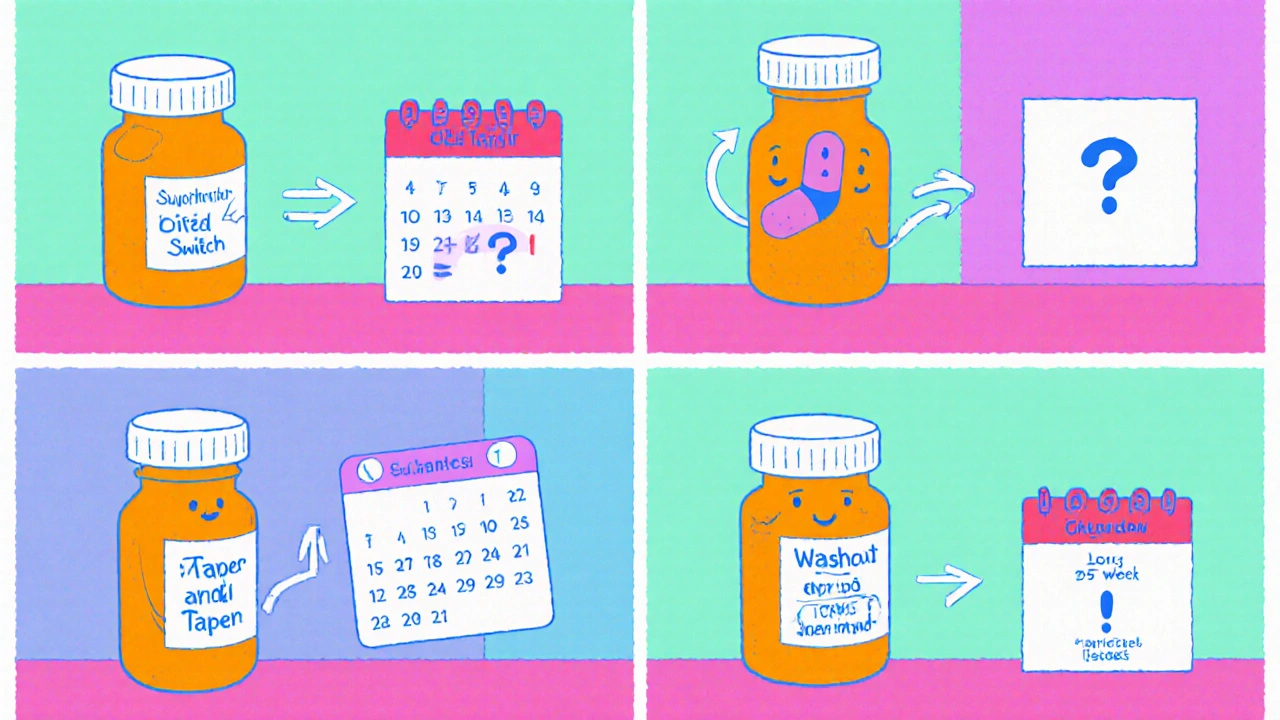When you need a new mood‑boosting pill, the process can feel like walking a tightrope. One misstep and you might get dizzy, anxious, or even risky serotonin overload. That’s why antidepressant switching isn’t just a medical term-it’s a practical roadmap to keep you steady while you change meds.
Why a Switch Becomes Inevitable
Most people start on an antidepressant hoping for relief within a few weeks. In reality, only about half experience full remission; the rest hit a wall of lingering symptoms, unwanted side effects, or both. Studies such as the STAR*D trial show 30‑50 % of patients need a change. Common culprits include sexual dysfunction (up to 73 % on SSRIs), weight gain (25‑50 % on certain drugs), and persistent nausea or insomnia. When the current pill stops helping or starts harming, a switch is the next logical step.
Four Core Switching Strategies
Guidelines from CANMAT, NICE, and the Australian Prescriber converge on four main approaches. Each one balances two goals: avoid withdrawal (the body’s reaction to stopping) and prevent serotonin syndrome (excess serotonin toxicity).
- Direct switch - stop the old medication today, start the new one tomorrow. Best for drugs with long half‑lives, like fluoxetine.
- Cross‑taper - slowly lower the first drug while simultaneously raising the second. This overlapping period (usually 10‑14 days) smooths out the dip in serotonin.
- Taper‑and‑switch - finish the first medication, then begin the new one the following day. Works when the first drug has a short half‑life but the patient can tolerate a brief drug‑free window.
- Washout period - stop the old pill, wait 2‑5 weeks (or longer for fluoxetine) before starting the next. Mandatory when swapping to or from MAOIs.
Choosing the Right Method for You
Think of the decision as a simple checklist:
- How long does the current drug stay in your system? Short half‑life meds (paroxetine, venlafaxine) often need a cross‑taper or a brief washout.
- Are you moving between drugs that both boost serotonin? If yes, a washout (especially before MAOIs) is non‑negotiable.
- Do you have a history of severe withdrawal ("brain zaps," dizziness, insomnia)? A slower taper over 6‑8 weeks may be worth it.
- How quickly do you need therapeutic effect from the new pill? Cross‑taper gives the fastest overlap.
Most clinicians favor the cross‑taper for its balance of safety and speed, unless you’re dealing with fluoxetine’s long tail or an MAOI.

Managing Withdrawal Symptoms
Withdrawal-not to be confused with a relapse-usually kicks in 1‑7 days after a dose drop. Typical signs are dizziness (28 % of cases), nausea (24 %), headaches (22 %), insomnia (19 %), and the infamous "brain zaps" (electric‑shock sensations reported by a third of paroxetine switchers). They tend to fade within a week if the taper is gentle.
Practical tips that cut discomfort by about a third, according to Mayo Clinic data:
- Take the pill with food to calm stomach upset.
- Snack on small, frequent meals instead of large ones.
- Suck on sugar‑free hard candy to ease dry mouth and mild nausea.
- Stay well‑hydrated; aim for 2‑3 L of fluid daily.
- Consider a short bridge with a low‑dose antihistamine (e.g., hydroxyzine) for anxiety spikes.
Serotonin Syndrome: Spot It Early
When two serotonergic drugs overlap accidentally, the nervous system can go into overdrive. Early symptoms include agitation, tremor, sweating, dilated pupils, and hyperreflexia. If you notice rapid heart rate, high fever, or rigidity, treat it as an emergency-call 911.
Because fluoxetine blocks the breakdown of many other antidepressants, a washout of at least 5 weeks is recommended before starting tricyclics, clomipramine, or any MAOI. Skipping this step has led to severe cases documented in the Australian Prescriber.
Real‑World Example: Switching from Paroxetine to Duloxetine
Maria, a 32‑year‑old teacher, had been on paroxetine 20 mg for two years. She loved the mood lift but dreaded the sexual side effects and occasional brain zaps. Her psychiatrist chose a cross‑taper:
- Week 1: Reduce paroxetine to 15 mg, start duloxetine 30 mg.
- Week 2: Paroxetine 10 mg, duloxetine 60 mg.
- Week 3: Paroxetine 5 mg, duloxetine 90 mg.
- Week 4: Stop paroxetine, continue duloxetine 90 mg.
Maria reported only mild nausea, which she managed by taking duloxetine with breakfast. By week 5 she felt steady, and the sexual side effects vanished. This mirrors the 42 % reduction in discontinuation symptoms seen in Zhou et al.’s 2021 meta‑analysis.

Monitoring and Follow‑Up
Guidelines suggest a check‑in within two weeks of the new drug start for most adults. Younger adults (18‑25) or anyone with suicidal thoughts should be seen at one week and again by week 4. During each visit, the clinician asks:
- Any new physical sensations (dizziness, tingling, headaches)?
- Changes in mood or anxiety levels?
- Sleep quality and appetite?
- Are side effects tolerable or worsening?
Adjustments-like slowing the taper or adding a temporary sleep aid-are made on the spot. The goal is to keep you on track without a sudden drop back into depression.
Future Tools: Pharmacogenetics and Ultra‑Low‑Dose Naltrexone
Genetic testing (e.g., GeneSight) can predict how you’ll metabolize certain antidepressants, boosting remission rates by about 28 % in the GUIDED II trial. The downside is cost: roughly $399 out‑of‑pocket in the U.S.
Another promising line is phase‑2 trials of ultra‑low‑dose naltrexone, which reduced discontinuation symptoms by a third during SSRI switches. While still experimental, these advances suggest tomorrow’s switches could be smoother, less guess‑work, and more personalized.
| Strategy | Ideal Candidates | Typical Duration | Washout Needed? | Key Risks |
|---|---|---|---|---|
| Direct Switch | Long‑half‑life drugs (e.g., fluoxetine) | 1‑2 days | No | Potential serotonin surge if both are serotonergic |
| Cross‑Taper | Same class or similar mechanisms, moderate half‑life | 10‑14 days overlap | Usually No | Withdrawal if taper too fast; mild serotonin overlap |
| Taper‑and‑Switch | Short‑half‑life meds (paroxetine, venlafaxine) | 2‑4 weeks taper + 1‑day gap | Rarely | Withdrawal peaks during gap |
| Washout Period | MAOI ↔ any serotonergic drug | 2‑5 weeks (5 weeks for fluoxetine) | Yes | Risk of relapse; must monitor mood closely |
Quick Checklist Before You Begin
- Write down current dose, start date, and half‑life of your existing antidepressant.
- Discuss with your prescriber which switching method fits your drug profile.
- Ask for a written taper schedule and a list of red‑flag symptoms.
- Set up a follow‑up appointment within 7‑14 days.
- Keep a simple symptom diary (time, intensity, any triggers).
Can I switch antidepressants on my own?
Never. Even “simple” switches can trigger withdrawal or serotonin syndrome. Always plan a switch with a prescriber who can tailor the taper and monitor you.
What’s the difference between a cross‑taper and a taper‑and‑switch?
A cross‑taper overlaps the two drugs, gradually decreasing the old while increasing the new. A taper‑and‑switch finishes the old drug completely, then starts the new one after a short gap.
How long does a washout period need to be?
It depends on the drugs’ half‑lives. For most SSRIs, 2‑4 weeks is enough. Fluoxetine, because of its long active metabolite, often requires a 5‑week washout before starting an MAOI.
What should I do if I experience severe withdrawal symptoms?
Contact your prescriber right away. They may pause the taper, add a short‑acting bridge medication, or adjust the dosage schedule. Severe symptoms like rapid heart rate, high fever, or intense anxiety need immediate medical attention.
Is pharmacogenetic testing worth the cost?
If you’ve switched multiple times with limited success, a test can guide selection and improve remission odds. For a first‑time switch, the $399 price may not be justified.



Hershel Lilly
26 October / 2025When you’re looking at switching antidepressants, the half‑life of the current drug is the first thing to check; it determines how quickly it clears and how you’ll need to taper. Fluoxetine, for example, stays in the system for weeks, so a direct switch can be safe, whereas paroxetine clears fast and usually needs a cross‑taper. Knowing the half‑life helps you avoid both withdrawal spikes and accidental serotonin buildup.